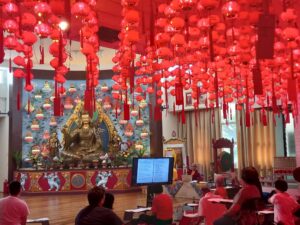In April, Phakchok Rinpoche led a 9-day pilgrimage with lamas and international students to the sacred land of Sikkim. Rinpoche presided over the profound accumulation practice of the Tukdrub Barche Kunsel and Tukdrup Sampa Lhundrup tsok bum, as well as the practice of Riwo Sangchö. The group practiced in the sacred locations of Drakar Tashi Ding and Sangchen Pema Yangtse Monastery. Moreover, the group practiced amidst the blessings and presence of Kyabchok Soktse Rinpoche’s kudung in Khecheopalri.
Guided by Guru Rinpoche in both visions and dreams, Rigdzin Gödem, the treasure-revealer, discovered beyul Dremojong, which later became known as Sikkim. Beyuls are valleys or areas of land (yul) that are hidden (bé) not only because of their secluded, largely inaccessible locations, but also because they are guarded by the Mahaguru himself. By concealing their spiritual qualities, Guru Padmasambhava has kept these locales pure of the many ways that humans contaminate sacred space.
The Wish-Fulfilling Lake of Khecheopalri is a tangible representation of Goddess Tara, with its distinct shape of the footprint of the Goddess herself. During Guru Padmasambhava’s visit to these sacred waters, he imparted profound teachings to a group of sixty-four dakinis. Situated on the southern slopes of the Himalayas, this lake is regarded as one of the most sacred in the region, drawing in revered masters and pilgrims for countless generations.
In due course, the esteemed master, Kyabchok Soktse Rinpoche (1928–2023), established Tashi Chöling nunnery on the sacred shores of the lake, ensuring the preservation and sanctity of its environment. The nunnery now enshrines Kyabchok Soktse Rinpoche’s precious kudung.
In his quest for tranquil places to practice the Dharma, Guru Rinpoche ventured into the valley of West Sikkim. During his time there, he discerned that the area now known as Tashi Ding held the spiritual essence of the valley. Although he didn’t seek to convert or construct buildings, Guru Rinpoche personally visited and sanctified every sacred location in West Sikkim, establishing Tashi Ding as a spiritual nucleus of the region.
In 1646 the renowned treasure-revealer Lhatsün Namkha Jikmé (1597–1653) journeyed to Sikkim during his final years, at the behest of his gurus in Tibet. While there, he revealed the Accomplishing the Life-Force of the Vidyadharas (Rigzin Sokdrup) cycle, from which the now widely propagated smoke offering practice of Mountain Smoke Offering (Riwo Sangchö) emerged. Furthermore, in 1705 Lhatsün Namkha Jikmé established Sangchen Pema Yangtse which stands as one of Sikkim’s oldest and most renowned monasteries.
Let us all make aspirations to visit or re-visit Sikkim for pilgrimage and dharma practice in the future. To learn more about Sikkim and more detail on some of the sacred sites, you may visit Nekhor.




















